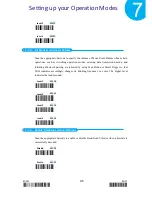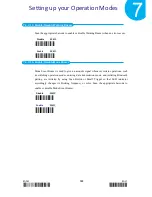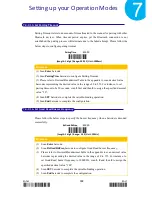
Enter 193 End
*/$%ENTR* *ZEND*
Setting up your Operation Modes
7
Procedure
(1)
Scan
Enter
barcode.
(2)
Scan
DateTimeSpareChar
barcode to configure the delimiter.
(3)
Please refer to ASCII Code Table and Decimal/Hexadecimal Table in the appendix
to scan hexadecimal value barcodes representing the desired string which has to be
1 character in length. For instance, to use “;” character to break down the output
string, scan
3
first and then
B
to assign the specified hexadecimal value “3B”.
(4)
Scan
SET
barcode to complete the variable-binding operation.
(5)
Scan
End
barcode to complete the configuration.
7-4-3-17.
Set Preamble Code
In the process of transmitting data, Preamble Code normally precedes both Prefix Code
and barcode data as a user-defined string to format the output data. Although Preamble
Code and Prefix Code work similarly to structure the transmitted message, functionality
they individually intend to perform differs. Basically, Preamble Code is designed to
arrange a layout using line terminators, such as carriage return, line fee, line separator,
paragraph separator and so on. Therefore, it is suggested to associate this configurable
parameter with equivalent ASCII code value for line terminators whenever you possibly
use preamble code in the hope of organizing the transmitted message. Please follow the
below steps to configure Preamble Code.
Procedure
(1)
Scan
Enter
barcode.
(2)
Scan
PreambleChar
barcode to configure Preamble Code.
(3)
Please refer to ASCII Code Table and Decimal/Hexadecimal Table in the
appendix to scan hexadecimal value barcodes representing the desired the
desired string which has to be at most 2 characters in length. For instance, to set
preamble code to be <CR><LF>, scan
0, D, 0,
and then A to assign the specified
hexadecimal value “0D0A”.
(4)
Scan
SET
barcode to complete the variable-binding operation.
(5)
Scan
End
barcode to complete the configuration.
*C0CE3*
PreambleChar
C0CE3
(Length: 2 digits)















































